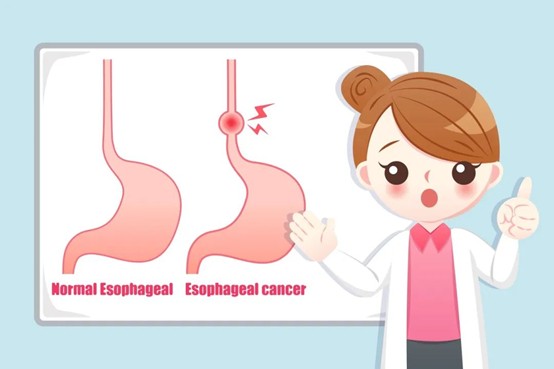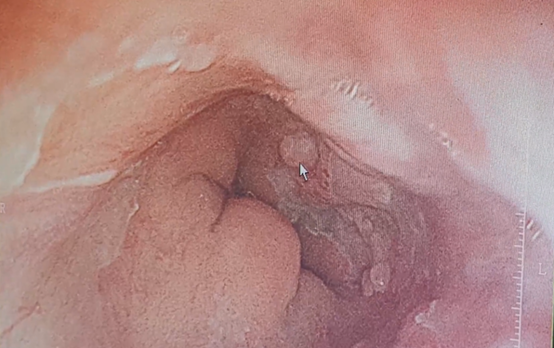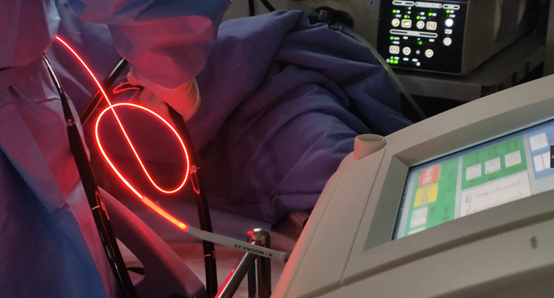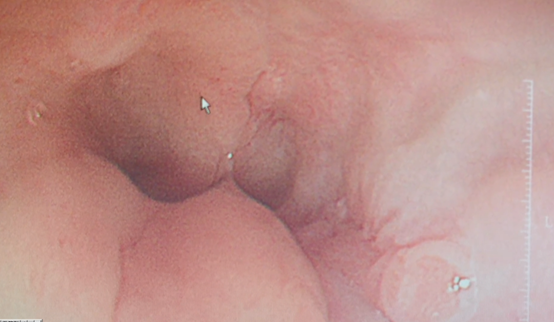Mr. Yu (alias), a man in his seventies, visited a local hospital in Macau in March last year due to black stools. Based on his symptoms, doctors performed a gastroscopy to determine the cause of the bleeding. As the endoscope was carefully inserted into his stomach, the doctors discovered two small lesions in his esophagus. A biopsy confirmed esophageal adenocarcinoma.

“If it weren’t for this examination, I might have taken a long time to discover this cancer.” The local doctors recommended surgical removal, but Mr. Yu, who had hypertension, uremia, and heart problems, believed that the surgical risks were too high, so he refused the procedure.
Later, Mr. Yu underwent endoscopic submucosal dissection (ESD) in Hong Kong, and post-surgical pathology confirmed adenocarcinoma at the esophagogastric junction. Although the procedure helped him avoid major surgery, some residual cancerous tissue remained. The local hospital suggested an esophagectomy and reconstruction surgery, but he declined once again.
"We had read reports about photodynamic therapy (PDT) for esophageal cancer." Mr. Yu and his wife explored various treatments that could be both effective and minimally invasive. After thorough research and consultation, in July 2024, Mr. Yu was admitted to the Third Medical Department of Guangzhou Fuda Cancer Hospital.

Pre-Treatment
"In principle, early removal of lesions yields better treatment outcomes." Director Xu Jiongyuan and his team at the Third Medical Department assessed Mr. Yu’s condition. Given that his esophagogastric junction mucosa was rough and had multiple raised lesions of approximately 2-3 mm in diameter, they confirmed early-stage adenocarcinoma. However, considering his multiple underlying diseases and refusal of radical surgery, the team devised a treatment plan—photodynamic therapy (PDT).
PDT is a clinically approved non-invasive treatment. According to the 2020 "Expert Consensus on Clinical Application of Photodynamic Therapy for Esophageal Cancer," endoscopic PDT can achieve curative effects for early-stage esophageal cancer. For advanced esophageal cancer, PDT can help relieve obstruction, control disease progression, and prolong survival, making it a safe and effective palliative treatment.

In PDT for esophageal cancer, a photosensitizer is injected into the body, selectively accumulating in tumor tissues. Specific wavelength laser irradiation then activates the photosensitizer, producing singlet oxygen and other free radicals that destroy cancer cells, leading to tumor necrosis. This endoscopic technique allows tumors to be "killed by light," precisely clearing the lesion while ensuring a safe, accurate, non-invasive, and highly effective treatment.
During his routine dialysis for uremia, Mr. Yu underwent two PDT sessions—an initial irradiation followed by a repeat irradiation. A follow-up examination three months later showed that the previously raised esophageal lesions had disappeared, replaced by a smooth surface, with no residual tumor detected. His condition was stable.

Post-Treatment
Thanks to the safety and non-invasiveness of PDT, Mr. Yu’s condition is now stable, without severe physical harm or impact on his other underlying diseases. He and his wife were highly satisfied: “This was our first time receiving treatment in Mainland China, and the results were gratifying. Initially, we were worried about language barriers, but there were no communication issues at all. The medical staff here were patient, meticulous, and provided excellent service.”
Early-Stage Esophageal Cancer Has a 90% Survival Rate
“We were fortunate to detect it early, or else the situation could have been much worse.” Mr. Yu and his wife repeated this sentiment multiple times during their conversation.
Esophageal cancer, though unfamiliar to many, is not far from our daily lives. It is a malignant tumor that originates from the esophageal epithelium, primarily classified into squamous cell carcinoma and adenocarcinoma.
In China, squamous cell carcinoma is more prevalent, accounting for the majority of cases. Globally, the incidence and mortality rates of esophageal cancer are alarmingly high. In China alone, esophageal cancer cases and deaths account for 53.7% and 55.3% of the global total, respectively—an astonishing statistic. However, early-stage esophageal cancer has a favorable prognosis, with a five-year survival rate of up to 90%! This underscores the critical importance of early detection for successful treatment and prognosis.
The danger of esophageal cancer lies in its subtle early symptoms. Many patients experience no discomfort initially, leading to delayed diagnosis. However, symptoms such as a foreign body sensation in the esophagus, slow passage of food, throat dryness or tightness, occasional difficulty swallowing, persistent dull pain, or a burning and stinging sensation should raise red flags. These may be early warning signs of esophageal cancer.
Individuals over 40, those living in high-risk regions, patients with precancerous upper digestive tract conditions (e.g., low-grade intraepithelial neoplasia, Barrett’s esophagus), a history of esophageal cancer, poor lifestyle habits (heavy smoking, excessive alcohol consumption, rapid eating, consumption of hot food), and those with missing teeth are advised to undergo regular endoscopic screenings to facilitate early detection and timely treatment of esophageal cancer.
